- Prelude
- Editorial
- Raghu Rai: The Historian
- Ryan Lobo, 34 in Baghdad
- Through the Eye of a Lensman
- Adrian Fisk
- And Quiet Flows the River
- The Lady in the Rough Crowd: Archiving India with Homai Vyarawalla
- Raja Deen Dayal:: Glimpses into his Life and Work
- Raja Deen Dayal (1844-1905) Background
- Vintage Views of India by Bourne & Shepherd
- The Outsiders
- Kenduli Baul Mela, 2008
- Collecting Photography in an International Context
- Critical Perspectives on Photograph(y)
- The Alkazi Collection of Photography: Archiving and Exhibiting Visual Histories
- Looking Back at Tasveer's Fifth Season
- Kodachrome: A Photography Icon
- Three Dreams or Three Nations? 150 Years of Photography in India, Pakistan and Bangladesh
- Show And Tell – Exploring Contemporary Photographic Practice through PIX
- Vintage Cameras
- Photo Synthesis
- The Right Way to Invest
- What Happened and What's Forthcoming
- Art Events Kolkata: March – April 2011
- Art Bengaluru
- Mumbai Art Sighting
- North East Opsis
- Previews
- In the News
- Somnath Hore
ART news & views
The Alkazi Collection of Photography: Archiving and Exhibiting Visual Histories
Volume: 3 Issue No: 16 Month: 5 Year: 2011
by Jennifer Chowdhry
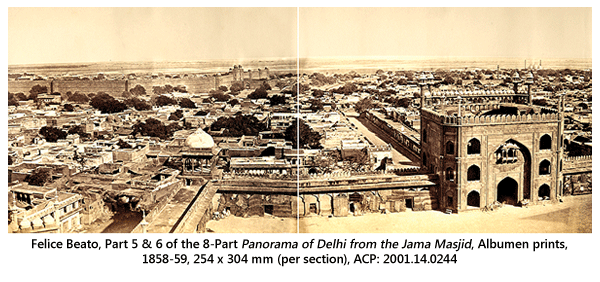
'An assemblage of work, objects, or things only becomes a collection by reason of the collector's knowledge, selectivity and insight'.¹ 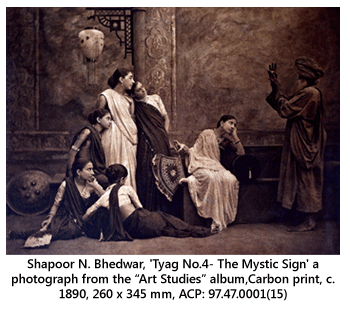
The same can be said in the case of Mr Ebrahim Alkazi, a private collector of vintage photographs, whose relentless patronage of the arts since 1960's eventually led to the establishment of the Alkazi Foundation for the Arts, a registered charitable trust based in New Delhi, India. His private collection of photographs housed in the Foundation is called the Alkazi Collection of Photography (ACP). As a result, the Foundation is dedicated to the documentation, study, research and preservation of 19th and early 20th Century photographs from India and South Asia.
The ACP is the reflection not only of Mr. Alkazi's love for photography but also of a deep interest in the documentary, aesthetic, cultural and modernist attitude towards the visual arts. The collection comprises works in the form of photographic albums, single prints, paper negatives, glass plate negatives, painted photographs and photo-postcards from India, Burma, Ceylon, Nepal, Afghanistan and Tibet. These vintage prints illustrate the progression of socio-political life in the Indian subcontinent through the interdisciplinary fields of archaeology, architectural history, anthropology, landscape, topography, military studies, and Princely India, beginning from 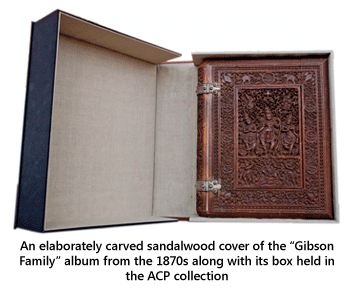 the 1840s and leading up to the rise of Modern India and its Independence in 1947. In addition, the archive has an extensive collection of the work of prominent Indian photographers and commercial photographic studios that flourished during the same period. Complementing this material, the ACP also holds documents and artifacts pertinent to the invention and development of photography.
the 1840s and leading up to the rise of Modern India and its Independence in 1947. In addition, the archive has an extensive collection of the work of prominent Indian photographers and commercial photographic studios that flourished during the same period. Complementing this material, the ACP also holds documents and artifacts pertinent to the invention and development of photography.
Over the last six years, The Alkazi Foundation has been committed to making this vast spectrum of vintage images available to the academic community and the general public, by acting as a centre for the research and study of photography and by disseminating this knowledge through a series of scholarly publications, exhibitions, seminars, conferences, workshops and archive visits. The Foundation has exhibited widely across India through collaborations with many national, state-run and private museums and art galleries.
The Foundation's Curator, Rahaab Allana has been assisted by a dedicated team, including Akshaya Tankha (Research Scholar) and Joyoti Roy (Archivist) to help curate and co-curate exhibitions across the country. The most recent being the The Marshall Albums: Photography and Archaeology, 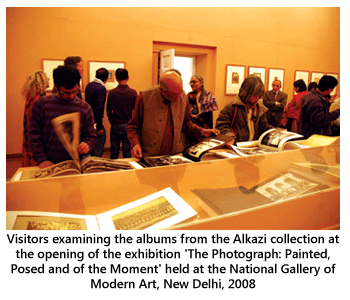 Historic Delhi: Early Explorations of the Camera, c. 1860-1950, The Artful Pose: Early Studio Photography in Mumbai, even Homai Vyarawalla: A Retrospective, a traveling exhibition curated by Sabeena Gadihoke being displayed at all the three centre's of the National Gallery of Modern Art in India. Homai Vyarawalla has recently given her entire collection of prints, negatives, cameras and other memorabilia on permanent loan to the ACP.
Historic Delhi: Early Explorations of the Camera, c. 1860-1950, The Artful Pose: Early Studio Photography in Mumbai, even Homai Vyarawalla: A Retrospective, a traveling exhibition curated by Sabeena Gadihoke being displayed at all the three centre's of the National Gallery of Modern Art in India. Homai Vyarawalla has recently given her entire collection of prints, negatives, cameras and other memorabilia on permanent loan to the ACP.
The collaborations also include institutions and galleries from outside India. Some of which are the Rencontres d'Arles, Brunei Gallery at SOAS, London and Fotomuseum, Winterthur.
With regard to scholarly publications, the ACP for each of its volume invites a specialist in the field, to examine a particular region or 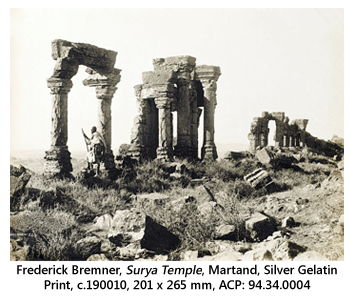 subject area represented in the archive. Till date, the ACP has brought several publications, namely, Lucknow: City of Illusion, Vijayanagara: Splendour in Ruins, The Waterhouse Albums: Central Indian Provinces and The Marshall Albums: Photography and Archaeology. A forthcoming publication from the collection is Photography and the Delhi Coronation Durbars: 1877, 1903, 1911. Through these publications the ACP tries to encourage a cross-disciplinary approach and interpretation of photography, taking into account current academic research on that particular theme.
subject area represented in the archive. Till date, the ACP has brought several publications, namely, Lucknow: City of Illusion, Vijayanagara: Splendour in Ruins, The Waterhouse Albums: Central Indian Provinces and The Marshall Albums: Photography and Archaeology. A forthcoming publication from the collection is Photography and the Delhi Coronation Durbars: 1877, 1903, 1911. Through these publications the ACP tries to encourage a cross-disciplinary approach and interpretation of photography, taking into account current academic research on that particular theme.
Archiving photography
Photography has become an important medium of communication and historicisation today. This co-relates with the exhibition Traces of the Uprising, 1857 that was organised by the Foundation in collaboration with the Delhi University in 2007. This exhibition was an attempt to visually trace the geography of unrest of the Revolt of 1857 through the reprints of rare 19th Century  photographs held in the archive juxtaposed with images documenting the current sites, with the help of some important maps. The Revolt brought a critical transformation in the communication media: by the use of photography as a form of reportage. These visual remnants become a means of analysing the physical impact of this historical event in the most critical centres.
photographs held in the archive juxtaposed with images documenting the current sites, with the help of some important maps. The Revolt brought a critical transformation in the communication media: by the use of photography as a form of reportage. These visual remnants become a means of analysing the physical impact of this historical event in the most critical centres.
The ability to catalogue objects and capture exact details has aligned the photograph with the archive, i.e. by classifying and organising the images for the purpose of record. More generally, photo-archives play an important role in cataloging photographs by adding an extra meaning that cannot be seen in the image itself (decoding the original information provided with the image like a caption or an explanatory text), so as to help users understand and interpret what they see. Early photographs were often produced to represent a thriving art form that was attractive to different groups for differing reasons. As they were not only intended as historical documents, it is important for the photo-archives to analyse them in light of their author and the context of their creation. The archives of today also need to play a major role in placing due attention not only on the materiality of the photograph as an art-object but also linking it to other disciplines like the history of science, anthropology and visual studies.
Apart from these considerations, the digitisation of the photography collection is an immediate concern for Indian archives so as to make these collections more accessible to their users and as a rational management choice from a preservation perspective. In 2006, the Foundation collaborated with EuroIndia (an organisation focusing on the history of economic and cultural relations between both regions through their documentary aspects), to organise the exhibition Lost Palaces of Delhi, bringing together reproductions of large paintings of the Mughal monuments and rare documents from the archives of Bibliothèque Nationale de France and the Victoria and Albert Museum, London. The digitisation of both these collections proved useful in the selection and process.
The archives' relationship with history is a symbiotic one. As much as history influences the motivation and creation of an archive, so do archives influence the shape of history to come. While the archives and archival practices with relation to photographs in India have been focused on the documentation of images of the past alone, 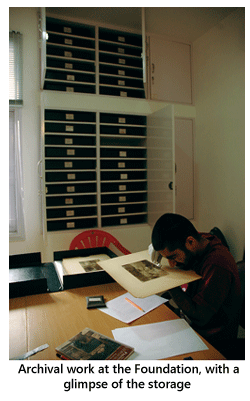 the need of the hour is to make a conscious effort to construct a bank for the present as well. By archiving contemporary works and the technologies that are used to produce them, photo-archives can help to document the photographic images as expressions of human thought, expression and creativity, exploring ideas of experience, memory, community and social history. Hence, acting as 'memory institutions' by serving users in the future.
the need of the hour is to make a conscious effort to construct a bank for the present as well. By archiving contemporary works and the technologies that are used to produce them, photo-archives can help to document the photographic images as expressions of human thought, expression and creativity, exploring ideas of experience, memory, community and social history. Hence, acting as 'memory institutions' by serving users in the future.
Thus, the ACP, which began as an individual's vision and connoisseurship of photography, has now expanded to the realm of a disciplinary practice, highlighting the significance of the 'archivist' in studying photography. The future of photo-archives greatly relies on the generation of new kinds of relationships to information by developing a platform for the historian, visual artist and cultural practitioners to engage in the archive as a site, form and source to appropriate, reconfigure and interrogate. By taking into account the number of images being created on a constant basis, the importance of photo-archival work and archivists has also come to the fore.
Jennifer Chowdhry is working as a Research Scholar with the Alkazi Foundation of the Arts, New Delhi.
Images Courtesy: The Alkazi Collection of Photography
¹Hartwell, Carroll. The Making of a Collection: Photographs from the Minneapolis Institute of Arts, Aperture, 1984, pg. 10